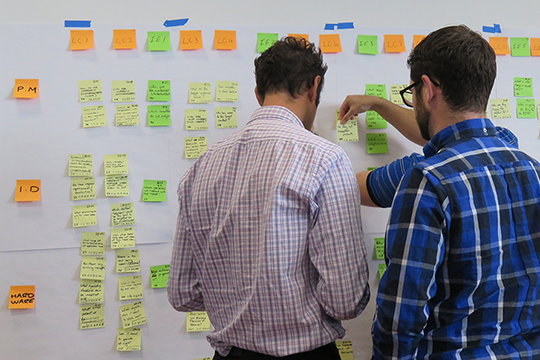We’ve been holding elections in the United States since before we were an independent nation. While claims of voter and election fraud have also been a part of American history from the beginning, the switch to electronic voting machines seems to have scaled up these problems. Some people now claim that millions of people voted illegally in the last major election, while others are concerned about security vulnerabilities that make electronic voting systems and registration databases open to hacking. Even the perception that these systems are vulnerable erodes confidence in our elections and in American democracy itself.
How did we get here? Leaving all political considerations aside, computerization shifted the nature of the problems that the elections boards needed to solve: from low cost of change and low uncertainty (paper ballots and voter rolls) to high cost of change and high uncertainty (electronic voting machines and registration databases). These two scenarios require different management systems, at least until we’ve driven the uncertainty out of electronic voting. Rapid Learning Cycles was developed for an environment of high uncertainty and high cost of change. Could it help the elections boards make better decisions about voting technology, even though they are not the developers?
Rapid Learning Cycles for High Cost of Change
and High Uncertainty Programs
Rapid Learning Cycles were developed and honed on early product development programs to build tangible products. These programs have high uncertainty, and the decisions made in early development often come with high costs of change if they must be revisited later in development. The Rapid Learning Cycles framework pulls out these Key Decisions for focused attention, because these are the decisions that drive long, slow learning cycles and hard-to-fix problems that don’t emerge until after launch.
We find areas of high uncertainty and high cost of change in other types of programs too, which explains why both traditional project management and Agile project management methods are insufficient to meet the challenges of these programs:
- Programs with low cost of change and low uncertainty (casual family gatherings) have a lot of margin for error, and may need only informal project management methods like to-do lists. The moment the cost-of-change or uncertainty goes up, teams need some type of project management.
- Programs with low cost of change and high uncertainty (app development) get the most benefit from Agile project management methods such as Scrum. Agile helps teams take advantage of the low cost of change to optimize the rest of their workflow and ultimately the product itself. Some Agile developers can even experiment on live customers since they can push updates out to customers immediately.
However, Agile methods are not as effective on their own at helping teams make good decisions when those decisions have high costs of change, or when there are a lot of dependencies between elements of the program, because Agile assumes that change is easy and features can be developed in any order.
- Programs with low uncertainty and high cost of change (construction projects) are the sweet spot for traditional project management methods, which are great at managing the dependencies between elements of a complex system that drive high costs of change. However, traditional project management methods break down in environments of high uncertainty, because the need to constantly update the plans increases management overhead and decreases visibility into the true current state of the program.
- Rapid Learning Cycles combine traditional project management’s awareness of the impact of change with Agile’s project management methods to address uncertainty. By making teams aware of the drivers of uncertainty and cost of change, they are better prepared to use their time effectively to lower the uncertainty and risk of costly changes.
What Drives Cost of Change and Uncertainty?
To recognize situations where Rapid Learning Cycles would be helpful, it’s especially important to understand the drivers of cost-of-change. For voting systems, the need to buy and maintain a lot of hardware, train elections officials and ensure compliance with election standards drives high cost-of-change. State and county budget processes also restrict the ability to change course after getting approval for a major investment.
The main drivers of uncertainty are “What do we already know?” and “How rapidly is that knowledge becoming obsolete?” The criticism from both sides of the political spectrum show that elections officials still have a lot to learn about how to build a secure voting system from registration to tabulation. Meanwhile, hackers’ tools constantly evolve to overcome new security strategies.
High Uncertainty / High Cost of Change Situations are Everywhere
Here are some other examples of situations you might encounter where High Uncertainty / High Cost of Change indicate the need for Rapid Learning Cycles:
- Advanced R&D: the fuzziest part of the Fuzzy Front End, where direction gets set for a company’s future competitive advantage. Since learning is the main purpose of these groups, it’s no surprise that Rapid Learning Cycles get traction here quickly.
- IT Infrastructure Programs: purchases of equipment and COTS software represent significant investments with high cost of change, in an environment where customer, technology and business needs continue to evolve at a fast pace.
- Culture Change: Large scale culture change initiatives carry all the uncertainty that arises from not knowing how the people in the organization will respond or the degree of support that senior leadership is willing and able to provide, including the need for leaders to change themselves first. A poorly-executed initiative cements the “old” culture in place even more firmly, and repeated attempts to change the culture lead to cynicism and disengagement in the organization.
- Strategy Development and Deployment: Strategy development is like early product development in the need to build a lot of knowledge in order to make decisions that will stick, yet the cost of change is even higher because changes in strategic direction impact entire organizations, not just single product teams.
- Mergers and Acquisitions: The decision to reorganize, merge with another company or to purchase one is a high-uncertainty decision that may be impossible to undo and cause a lot of organizational disruption.
RLCs Close the Program Management Gap
The challenges of high uncertainty and high cost-of-change within electronic voting decisions were highlighted at an IT security conference last week. Hackers were given a set of real voting machines to break into. The hackers defeated all of the voting machines’ security safeguards within 90 minutes. All of these machines were expensive to acquire and maintain, and none were secure enough to withstand even a mild attack.
All of this points towards an environment of high uncertainty / high cost of change — a natural fit for Rapid Learning Cycles to help elections boards make better decisions about how to use computerization effectively to run secure elections, how to use computerization to address the inherent vulnerabilities of the elections process itself, how to mitigate the new vulnerabilities that computerized voting has introduced, and how to make the most of their budgets when they make decisions that they will need to live with.



